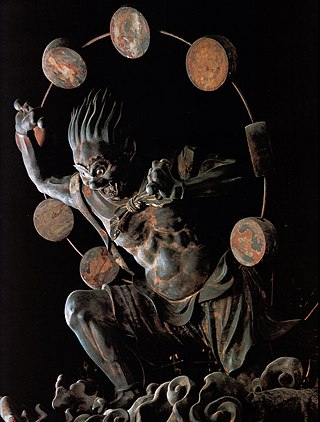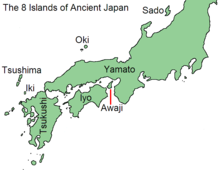
Amaterasu Ōmikami, often called Amaterasu for short, also known as Ōhirume no Muchi no Kami (大日孁貴神), is the goddess of the sun in Japanese mythology. Often considered the chief deity (kami) of the Shinto pantheon, she is also portrayed in Japan's earliest literary texts, the Kojiki and the Nihon Shoki, as the ruler of the heavenly realm Takamagahara and as the mythical ancestress of the Imperial House of Japan via her grandson Ninigi. Along with two of her siblings she ranks as one of the "Three Precious Children", the three most important offspring of the creator god Izanagi.
Susanoo, often referred to by the honorific title Susanoo-no-Mikoto, is a kami in Japanese mythology. The younger brother of Amaterasu, goddess of the sun and mythical ancestress of the Japanese imperial line, he is a multifaceted deity with contradictory characteristics, being portrayed in various stories either as a wild, impetuous god associated with the sea and storms, as a heroic figure who killed a monstrous serpent, or as a local deity linked with the harvest and agriculture. Syncretic beliefs of the Gion cult that arose after the introduction of Buddhism to Japan also saw Susanoo becoming conflated with deities of pestilence and disease.
The Kojiki, also sometimes read as Furukotofumi or Furukotobumi, is an early Japanese chronicle of myths, legends, hymns, genealogies, oral traditions, and semi-historical accounts down to 641 concerning the origin of the Japanese archipelago, the kami (神), and the Japanese imperial line. It is claimed in its preface to have been composed by Ō no Yasumaro at the request of Empress Genmei in the early 8th century (711–712), and thus is usually considered to be the oldest extant literary work in Japan.

Japanese mythology is a collection of traditional stories, folktales, and beliefs that emerged in the islands of the Japanese archipelago. Shinto traditions are the cornerstones of Japanese mythology. The history of thousands of years of contact with Chinese and various Indian myths are also key influences in Japanese religious belief.

Yomi or Yomi-no-kuni is the Japanese word for the land of the dead. According to Shinto mythology as related in Kojiki, this is where the dead go in the afterlife. Once one has eaten at the hearth of Yomi it is (mostly) impossible to return to the land of the living. Yomi is most commonly known for Izanami's retreat to that place after her death. Izanagi followed her there and upon his return he washed himself, creating Amaterasu, Susanoo, and Tsukuyomi-no-Mikoto in the process.

Raijin, also known as Kaminari-sama (雷様), Raiden-sama (雷電様), Narukami (鳴る神), Raikou (雷公), and Kamowakeikazuchi-no-kami is a god of lightning, thunder, and storms in Japanese mythology and the Shinto religion. He is typically depicted with fierce and aggressive facial expressions, standing atop a cloud, beating on den-den daiko drums with tomoe symbols drawn on them. Iconography of Raijin are often found in Japanese temples and shrines. He is usually depicted alongside Fūjin, the god of wind.

Izanami (イザナミ), formally referred to with the honorific Izanami-no-Mikoto, is the creator deity of both creation and death in Japanese mythology, as well as the Shinto mother goddess. She and her brother-husband Izanagi are the last of the seven generations of primordial deities that manifested after the formation of heaven and earth. Izanami and Izanagi are held to be the creators of the Japanese archipelago and the progenitors of many deities, which include the sun goddess Amaterasu, the moon deity Tsukuyomi and the storm god Susanoo. In mythology, she is the direct ancestor of the Japanese imperial family. In Shinto and Japanese mythology, Izanami gave humans death, so Izanami is sometimes seen as a shinigami.

Tsukuyomi-no-Mikoto, or simply Tsukuyomi or Tsukiyomi (ツキヨミ), is the moon kami in Japanese mythology and the Shinto religion. The name "Tsukuyomi" is a compound of the Old Japanese words tsuku and yomi. The Nihon Shoki mentions this name spelled as Tsukuyumi, but this yumi is likely a variation in pronunciation of yomi. An alternative interpretation is that his name is a combination of tsukiyo and mi. -no-Mikoto is a common honorific appended to the names of Kami; it may be understood as similar to the English honorific 'the Great'.

Ōyama-tsumi or Ohoyama-tsumi, also Ōyama-tsumi-mi'oya-no-mikoto (大山祇御祖命), is a god of mountains, sea, and war in Japanese mythology. He is an elder brother of Amaterasu and Susanoo. His other names are Watashi-no-Ōkami (和多志大神) and Sakatoke (酒解神).

Ōkuninushi, also known as Ō(a)namuchi or Ō(a)namochi among other variants, is a kami in Japanese mythology. He is one of the central deities in the cycle of myths recorded in the Kojiki and the Nihon Shoki alongside the sun goddess Amaterasu and her brother, the wild god Susanoo, who is reckoned to be either Ōkuninushi's distant ancestor or father. In these texts, Ōkuninushi (Ōnamuchi) is portrayed as the head of the kunitsukami, the gods of the earth, and the original ruler of the terrestrial world, named Ashihara no Nakatsukuni. When the heavenly deities (amatsukami) headed by Amaterasu demanded that he relinquish his rule over the land, Ōkuninushi agreed to their terms and withdrew into the unseen world, which was given to him to rule over in exchange. Amaterasu's grandson Ninigi then came down from heaven to govern Ashihara no Nakatsukuni and eventually became the ancestor of the Japanese imperial line.
Okami in the Kojiki, or in the Nihon Shoki: Kuraokami (闇龗) or Okami (龗), is a legendary Japanese dragon and Shinto deity of rain and snow. In Japanese mythology, the sibling progenitors Izanagi and Izanami gave birth to the islands and gods of Japan. After Izanami died from burns during the childbirth of the fire deity Kagu-tsuchi, Izanagi was enraged and killed his son. Kagutsuchi's blood or body, according to differing versions of the legend, created several other deities, including Kuraokami.

In Shinto chronology, the Age of the Gods is the period preceding the accession of Jimmu, the first Emperor of Japan. The kamiyo myths are chronicled in the "upper roll" (Kamitsumaki) of the Kojiki and in the first and second chapters of the Nihon Shoki. The reigns of Emperor Jimmu and the subsequent Emperors are considered the Human Age.
In Japanese mythology, the story of the birth of the gods occurs after the creation of Japan (Kuniumi). It concerns the birth of the divine (kami) descendants of Izanagi and Izanami.
In Japanese mythology, the Japanese Creation Myth is the story that describes the legendary birth of the celestial and creative world, the birth of the first gods, and the birth of the Japanese archipelago.

Izanagi Jingū (伊弉諾神宮) is a Shinto shrine in the Taga neighborhood of the city of Awaji in Hyōgo Prefecture, Japan. It is the ichinomiya of former Awaji Province. The main festival of the shrine is held annually on April 22.

Kukurihime no Kami (菊理媛神), also Kukurihime no Mikoto (菊理媛命), is a Japanese Shinto goddess venerated as Shirayama Hime (白山比咩) at Shirayama Hime Shrine in Hakusan, Ishikawa Prefecture. She is equated with the mountain Hakusan (白山) in Ishikawa province at Hakusanhime shrine. She is mentioned in the Nihongi, but not in the Kojiki. She mediated between Izanagi and Izanami after the former escaped from the land of the dead, Yomi no Kuni. She is also venerated at Yasukuni Shrine in Tokyo and at Yōrō Shrine in Gifu Prefecture. Kukuri appears very briefly during the myth of Yomi, after Izanagi used the great god Michikaeshi Ōkami to block the entry to Yomi no kuni. Her words are praised by Izanagi, but what she said to him was not recorded, despite Kukurihime's popularity as demonstrated by her worship at 3,000 shrines across Japan. She was later merged with Kannon Bosatsu following Shinbutsu-shūgō ideas.
The kuni-yuzuri (国譲り) "Transfer of the land" was a mythological event in Japanese prehistory, related in sources such as the Kojiki and the Nihon Shoki. It relates the story of how the rulership of Japan passed from the earthly kami (kunitsukami) to the kami of Heaven (amatsukami) and their eventual descendants, the Imperial House of Japan.

Ashinazuchi and Tenazuchi are a pair of Japanese deities. They are the parents of Kushinadahime, the wife of Susanoo-no-Mikoto. The serpent killed their other 7 daughters.


















